This vegan cauliflower Alfredo sauce turns a nutritious vegetable into the base of a delightful, creamy dairy-free pasta sauce! You can store the sauce or use it to make an easy vegan Alfredo pasta with spinach.
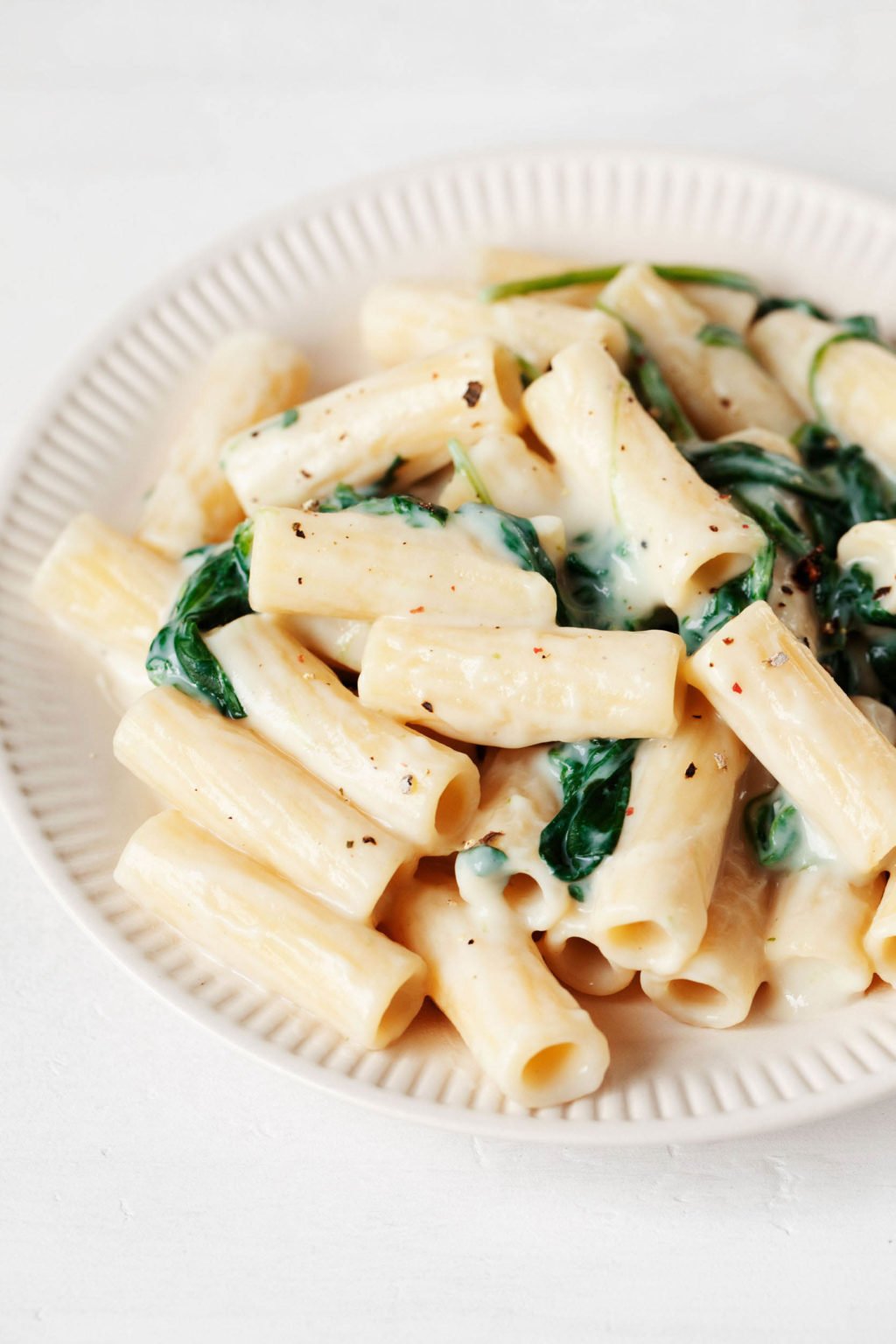
There’s nothing like diving into a comforting bowl of pasta for dinner. When that meal is also easy and nutritious, it’s even better.
This creamy cauliflower Alfredo sauce and pasta is exactly such a meal, and I’m so happy to share it.
I’ve seen a bunch of recipes for cauliflower Alfredo sauce over the years. Most recently, I stumbled on this one from the folks at Purple Carrot, which looked great.
I loved the idea of adding spinach to the finished pasta. I try to add greens to my meals whenever I can, and pasta is a good vehicle for them.
In the last few weeks, I’ve experimented with a few batches of creamy, cauliflower Alfredo sauce. I decided to add a nut or seed to the sauce—more on that below—and I’m really happy with the result.
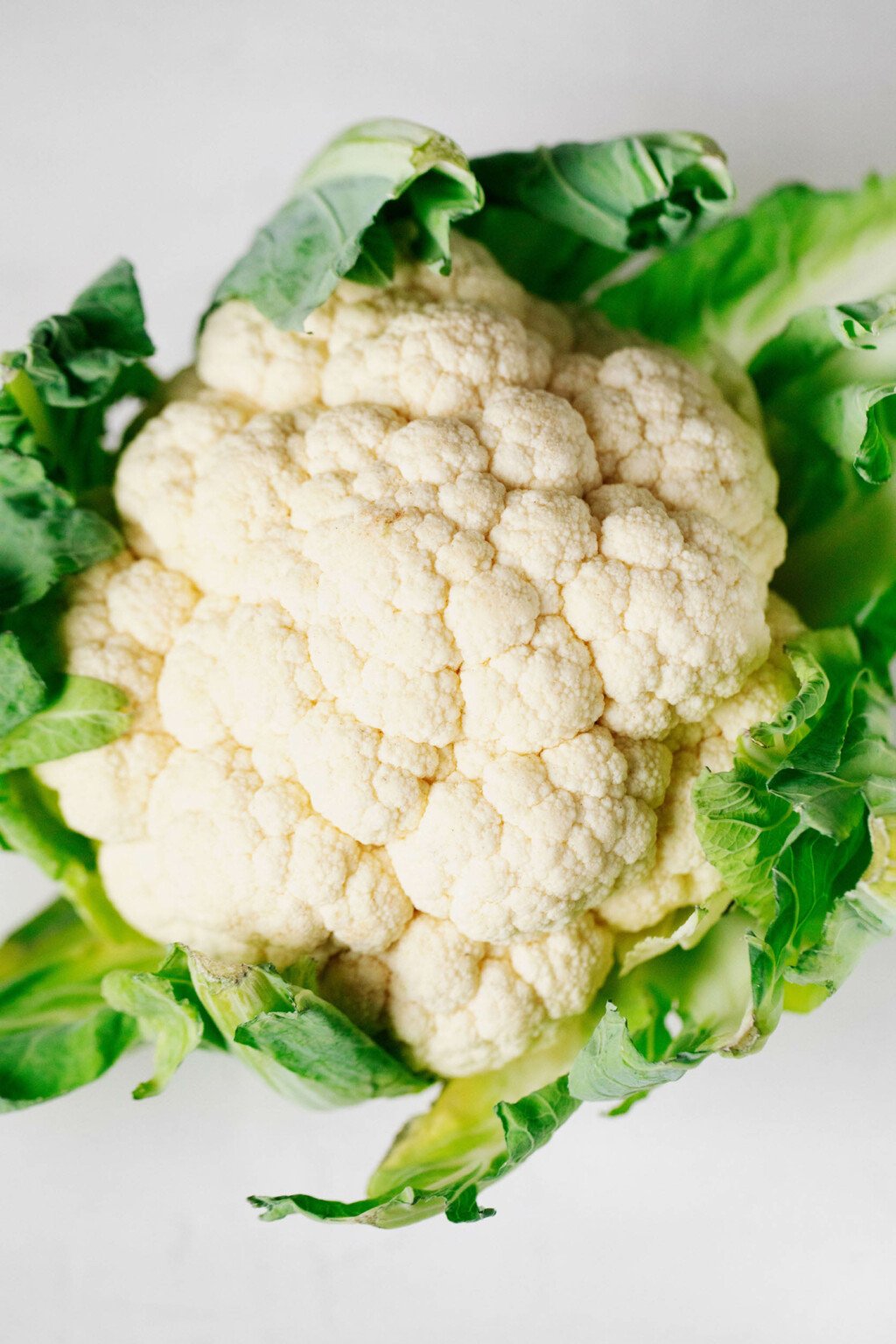
Cauliflower Alfredo sauce ingredients
I love this recipe for its nutrition and flavor. However, I also love the simplicity of its ingredients.
Cauliflower
Is there anything cauliflower can’t do?
Here, it provides a creamy and nutrient-dense base for a garlicky sauce. I’d love to try the cauliflower Alfredo sauce with broccoli in place of cauliflower at some point, but the color would of course be very different.
Nuts or seeds
I’ve made this sauce a few times, which means that I’ve had a chance to add different nuts and seeds.
They increase the creaminess of the cauliflower Alfredo sauce, and they also add healthful fat and overall good nutrition.
For example, I’ve added tahini and cashew butter to the sauce. Each works well for creaminess. Cashew butter is a little sweeter, while tahini is slightly more bitter.
I’ve also tried adding a few tablespoons of shelled hemp seeds, which are a great source of protein.
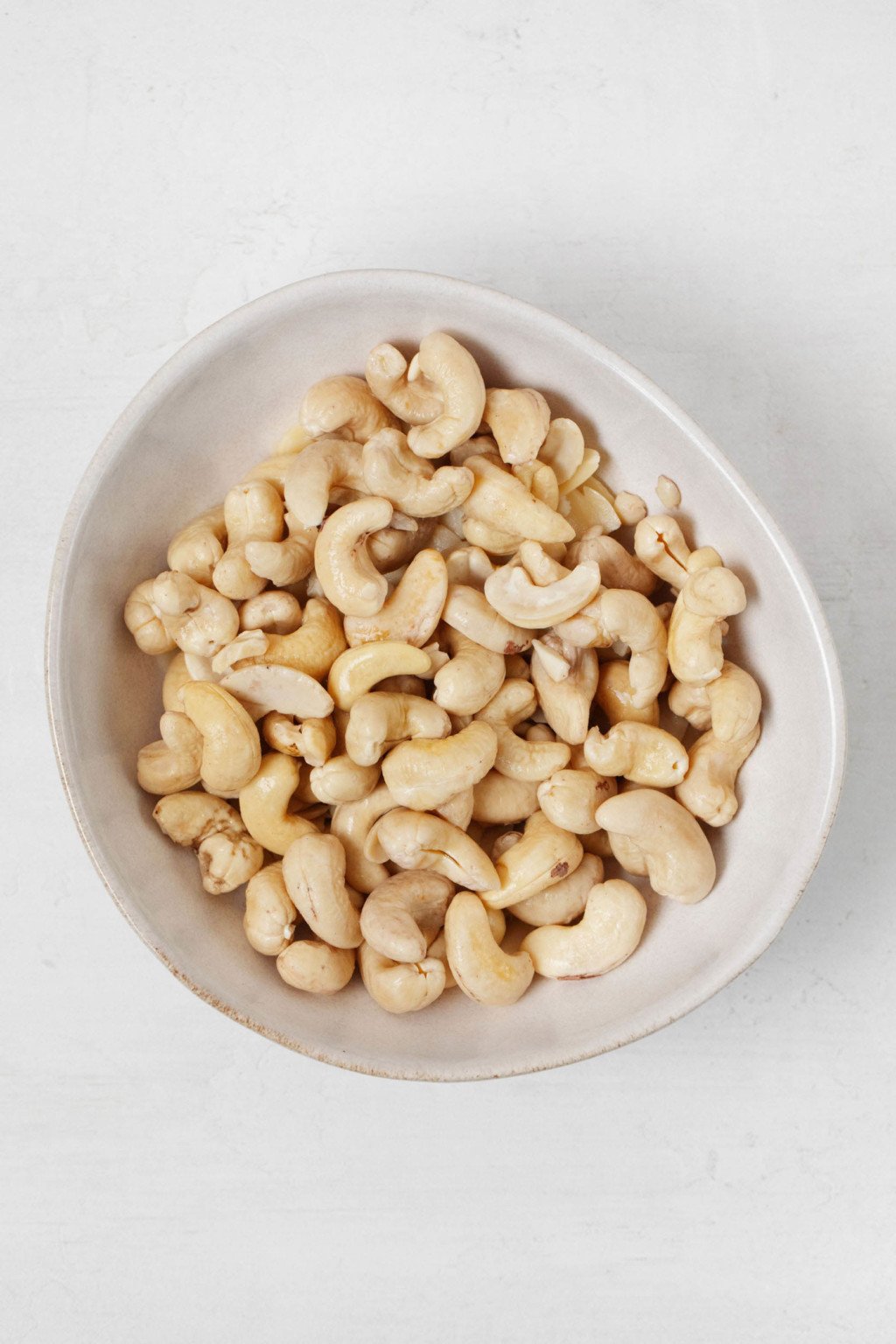
Finally, I’ve tried the cauliflower Alfredo sauce with soaked, raw cashews. Cashews are the basis of my simple cashew cheese and cashew cream. They work magic in creamy, dairy free recipes.
Nutritional yeast
Nutritional yeast adds a “cheesy” flavor to the cauliflower Alfredo sauce.
Garlic
The garlic in this recipe can be adjusted to taste. I’m sensitive to strong garlic flavor in cooking, so I have a light touch with it. If you love garlic, you should certainly add as much as you’d like.
White miso
Miso adds both saltiness and some umami to the cauliflower Alfredo sauce. If you don’t have white miso at home, you can omit it and add a little extra salt to the sauce instead.
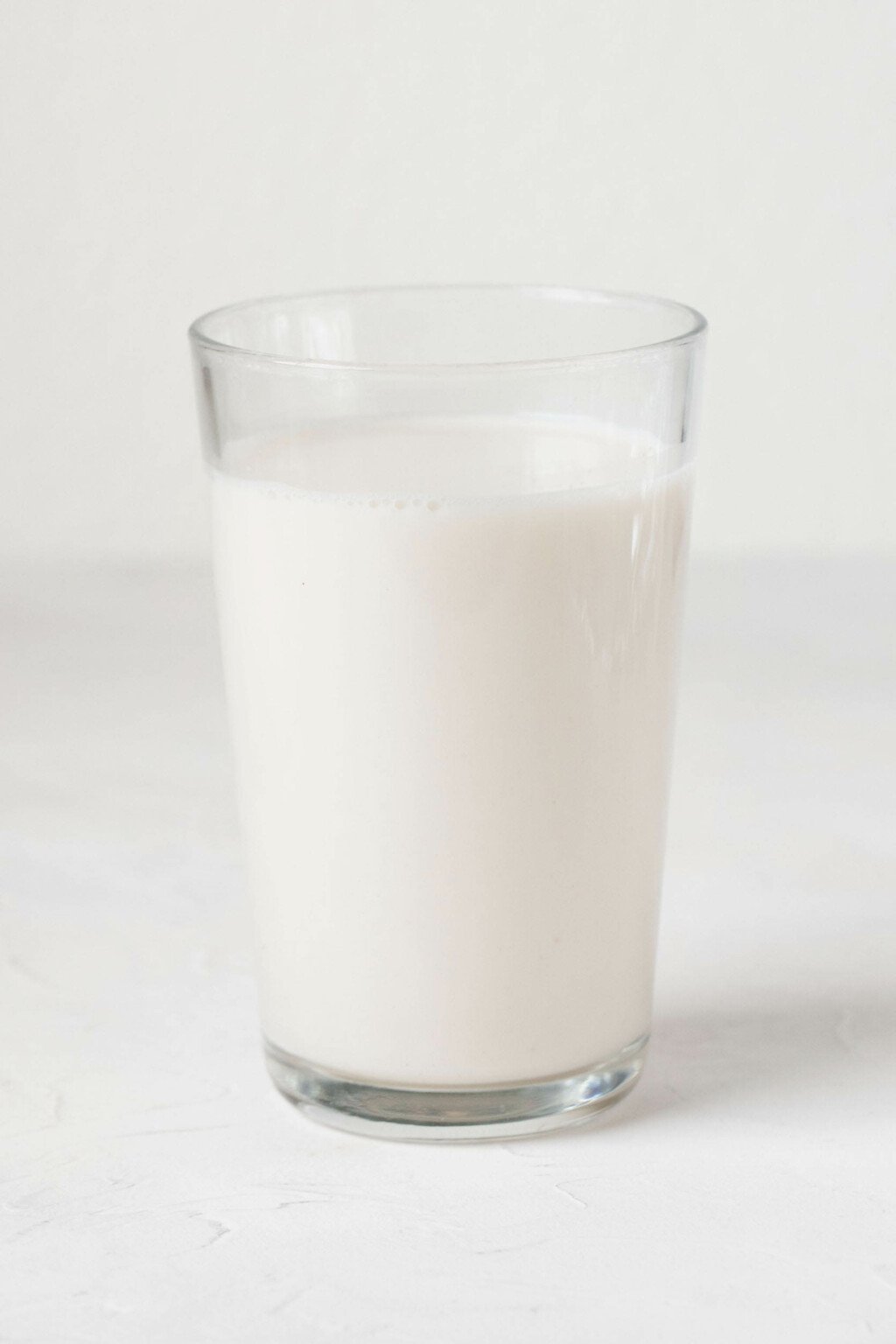
Non-dairy milk
Unsweetened plant milk is another source of creaminess for the Alfredo pasta. I like to make this recipe with unsweetened oat or soy milk; the latter will add some protein. Unsweetened cashew milk is also a good choice for the recipe.
How to make cauliflower Alfredo sauce
Ease of preparation is one of the best things about this pasta. My goal when I made it was to combine as many steps as possible.
Step 1: steam the cauliflower
In this first step, you’ll bring a few inches of water to boil in a large pot. Fit that pot with a steamer attachment and steam the cauliflower until it’s quite tender (8-10 minutes).
Step 2: cook the pasta
In this step, you’ll remove the steamer attachment from the pot and add salted water. Bring this water to a boil and cook your pasta according to package instructions.
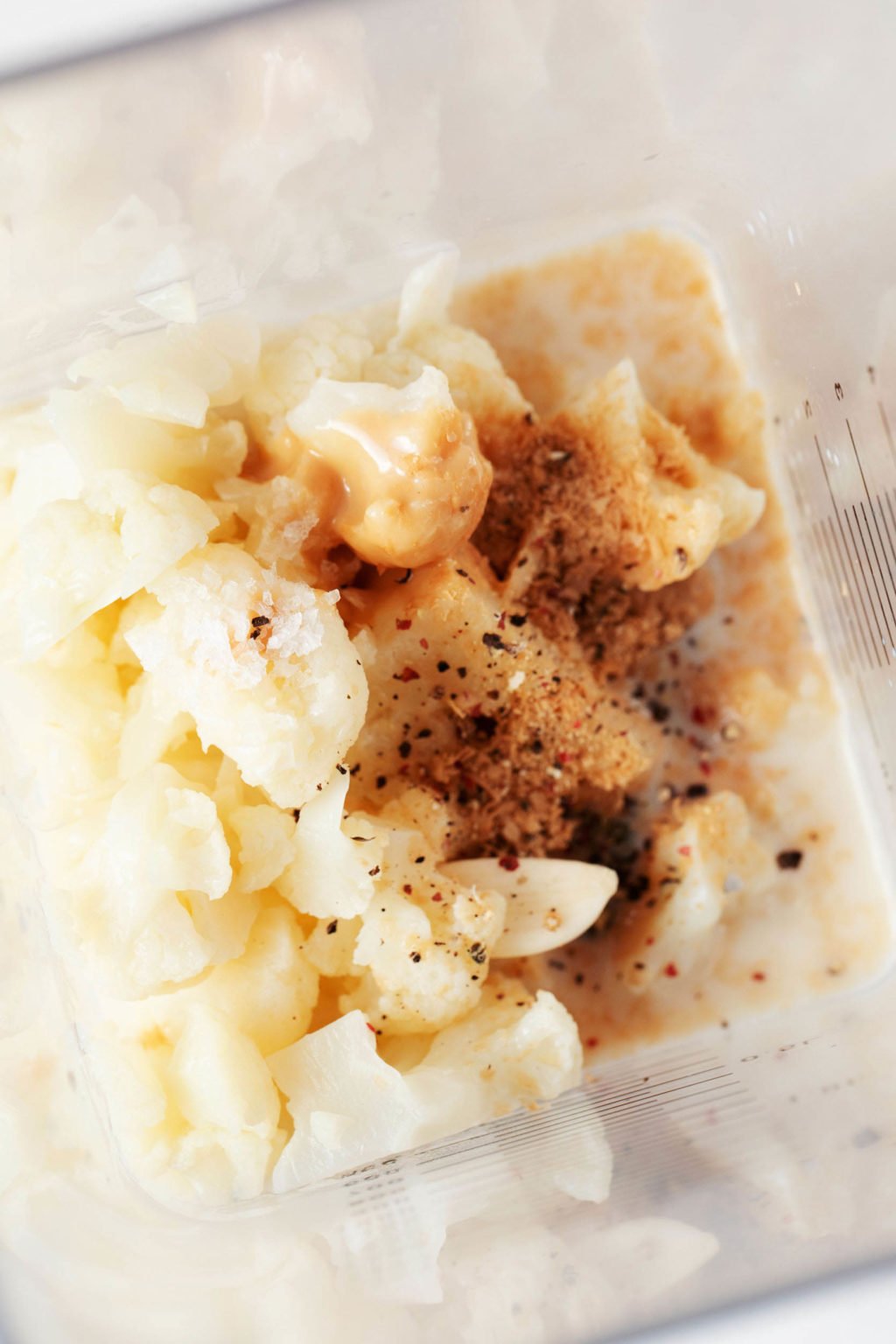
Step 3: blend the sauce
While the pasta cooks, you can prepare your sauce.
The base of this sauce will be your cooked cauliflower. Remaining ingredients are non-dairy milk (I use unsweetened soy, which will contribute some protein), nutritional yeast, miso, lemon juice, a nut or seed, garlic, and sea salt.
Blend the sauce for 1-2 minutes in a high-powered blender, or until the sauce is smooth.
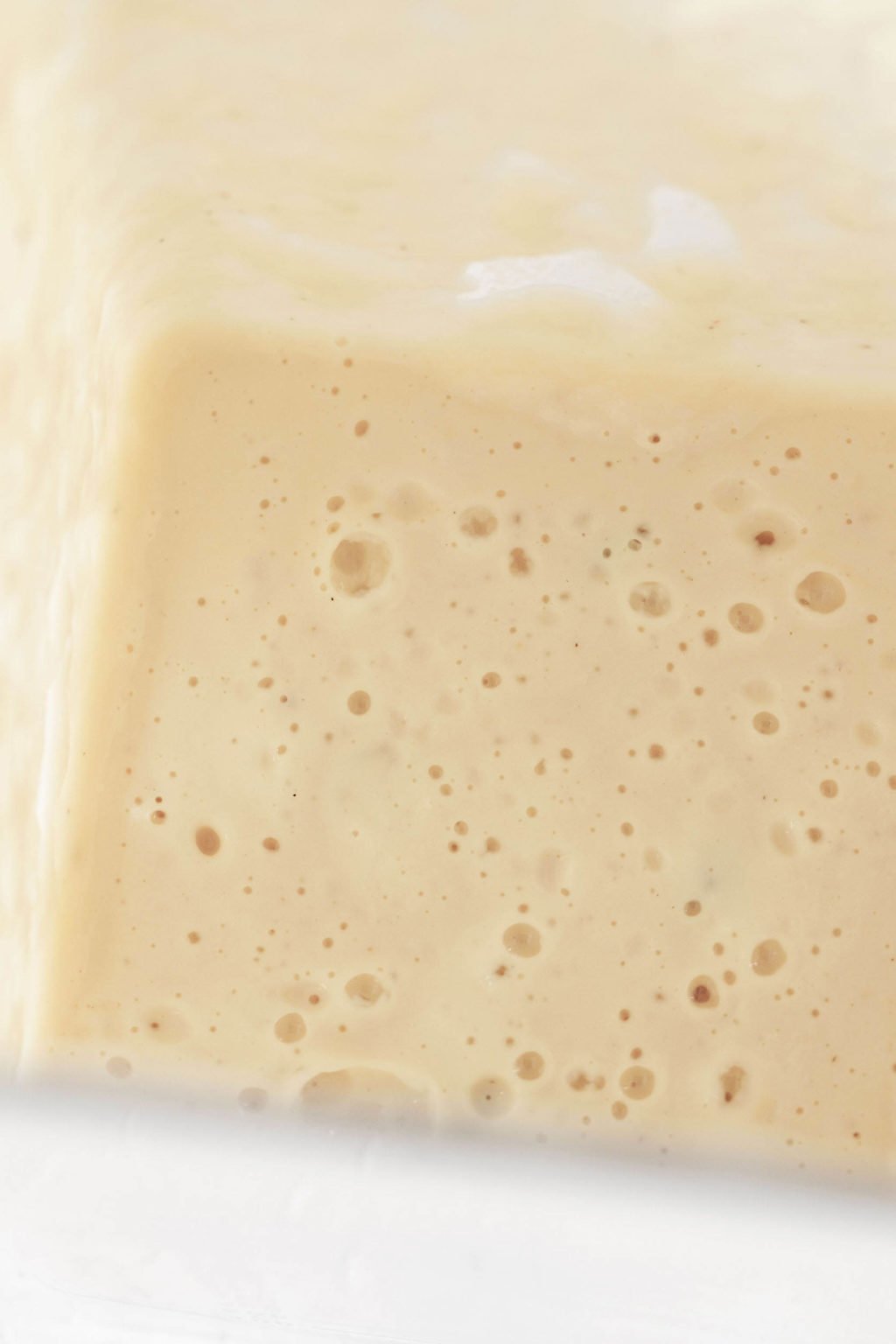
Step 4: add spinach to the pasta
I love adding vegetables to pasta as it cooks. While it isn’t possible to condense steps like this in every recipe, it’s a great way to save time.
Here, you’ll add some spinach (or kale, or another green) to the pasta a few minutes before it finishes cooking.
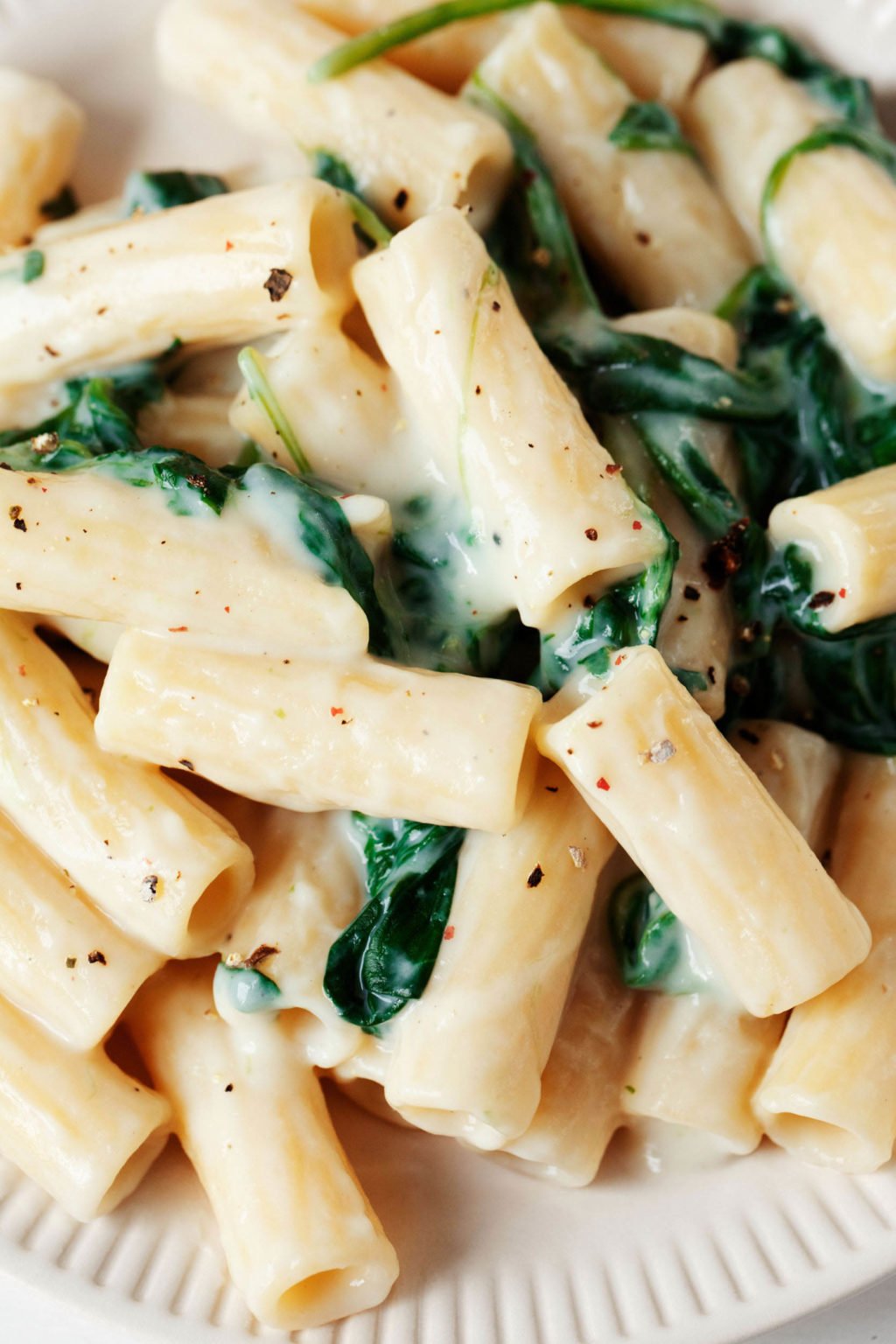
Step 5: combine ingredients
Once the sauce is ready and the pasta and spinach have been cooked and drained, you’ll add all ingredients back to the pot you’ve been using.
Mix the ingredients well over low heat. When the pasta is creamy and hot throughout, as well as evenly mixed, you’ll be ready to enjoy this meal.
Preparation & storage
You can use the cauliflower Alfredo sauce with pasta immediately after you make it. You can also store it for future use.
The sauce will keep in an airtight container in the fridge for up to four days after you prepare it.
Can cauliflower Alfredo sauce be frozen?
Yes, you can definitely freeze the cauliflower Alfredo sauce!
I like to do this in large, wide-mouthed mason jars. I’m careful to leave some head space at the top of the jar, which prevents the jar from cracks as the liquid inside freezes and expands.
The sauce can be frozen for up to six weeks.
Variations & additions
Spinach adds color and nutrition to an already wholesome pasta. However, you can add additional vegetables as you like.
Broccoli florets, additional steamed cauliflower florets, cut green beans, peas, steamed zucchini or summer squash, and steamed kale would all make wonderful additions.

Cauliflower Alfredo Sauce
Author –Ingredients
Cauliflower Alfredo sauce
- 1 small head cauliflower, thick stem removed and cut into florets and pieces (about 1 lb after preparation)
- 1 cup unsweetened oat, cashew, or soy milk
- 1/4 cup nutritional yeast
- 1 tablespoon white miso
- 1 1/2 tablespoons freshly squeezed lemon juice
- 2 tablespoons raw cashew butter, tahini, or shelled hemp hearts (alternatively, you can use 1/4 cup soaked and drained raw cashews)
- 1 clove raw garlic
- 1/2 teaspoon fine salt (extra for the pasta water, if making)
- Freshly ground black pepper or crushed red pepper flakes, to taste
Pasta & spinach
- 8 ounces medium pasta shape of choice (I like penne, fusilli, casarecce, and rigatoni for this recipe)
- A few big handfuls of baby spinach or washed and chopped kale leaves
- cashew parmesan cheese (optional, for serving)
Instructions
- Bring a large pot of water to a boil. Fit the pot with a steamer attachment. Steam the cauliflower till fork tender (about 10 minutes). If you're preparing the cauliflower Alfredo spinach pasta, reserve the boiling water.
- To prepare the cauliflower Alfredo sauce, add the cooked cauliflower, milk, nutritional yeast, miso, lemon juice, nut/seed butter, hemp hearts, or cashews, garlic, and sea salt to a powerful blender. Blend till smooth. Taste and add freshly ground black pepper or crushed red pepper to your liking.
- To prepare the pasta: remove the steamer attachment from the boiling water once the cauliflower is ready. Salt the water. Add the pasta and cook according to package instructions. In the last 3 minutes of cooking time, add the spinach or kale to the pasta and simmering water.
- Drain the pasta and greens and return them to the pot. Add the blended cauliflower Alfredo sauce. Mix everything and adjust salt as needed; add freshly ground black pepper to taste. Serve, topped with cashew parmesan if desired.
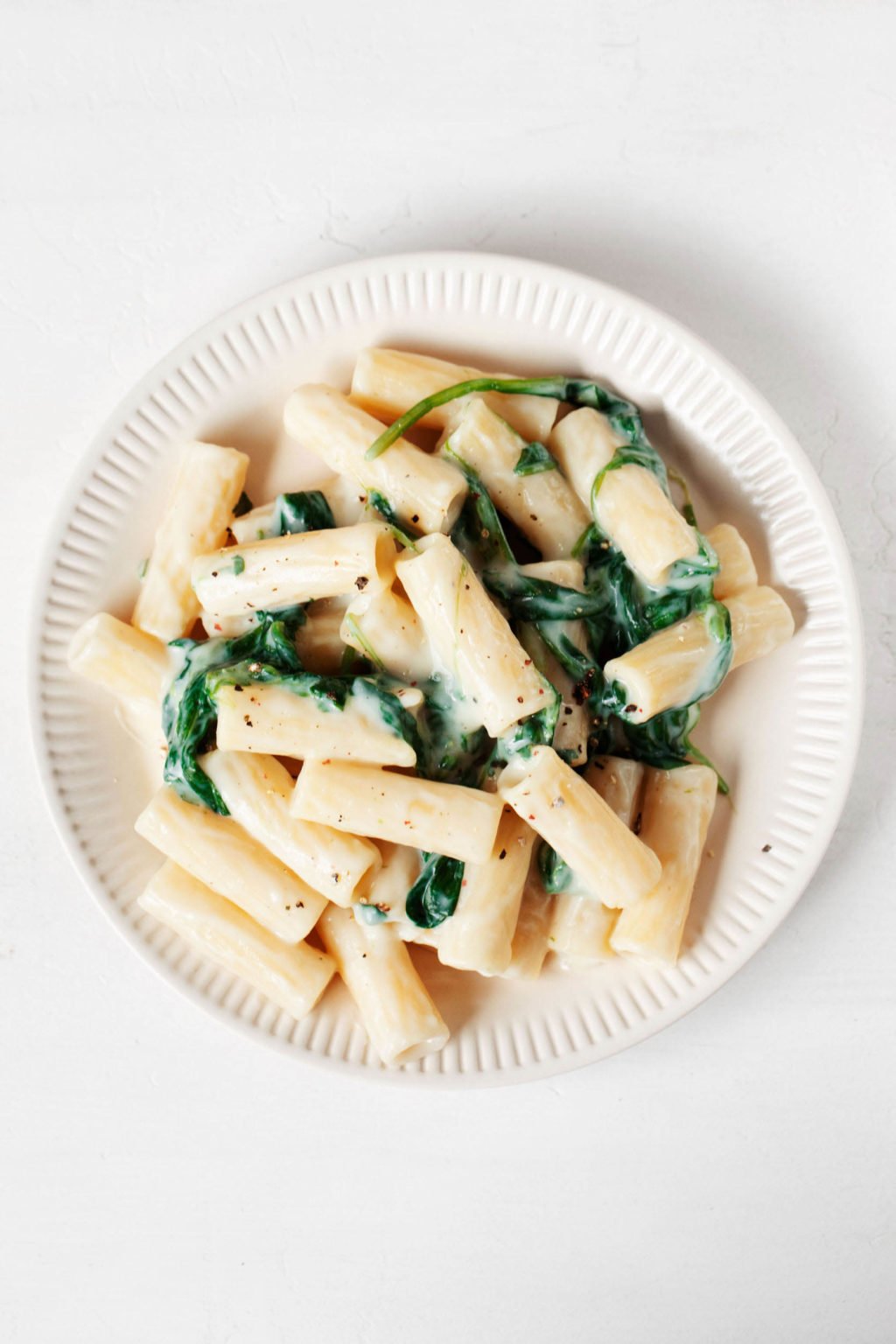
I hope that this simple pasta meal will bring you the same comfort and good nutrition it has brought me in the past few, hectic weeks.
The cauliflower Alfredo sauce itself is a versatile keeper. Use it with any pasta shape, drizzle it over baked potatoes or steamed greens, and so on. It’ll deliver on nourishment and creamy goodness no matter what.
xo
This post was originally sponsored by the Seed Daily Synbiotic.
This post may contain affiliate links. If you use these links to buy something I may earn a commission. Visit my privacy policy to learn more.
Method: Blender, Stovetop
Ingredients: Cauliflower
Dietary Preferences: Gluten Free, No Oil, Soy Free, Tree Nut Free, Vegan
Recipe Features: 30 Minute or Less, Quick & Easy

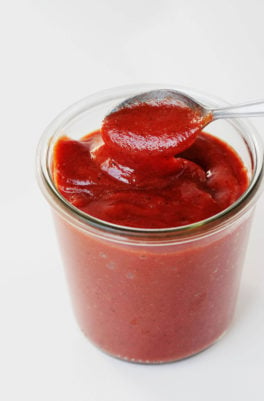
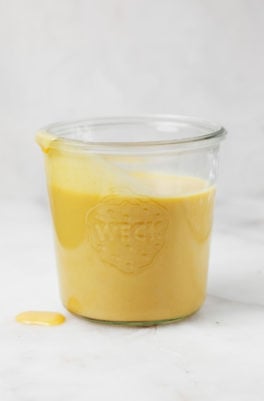
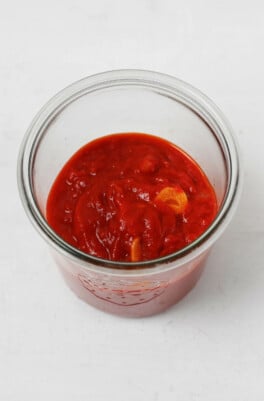
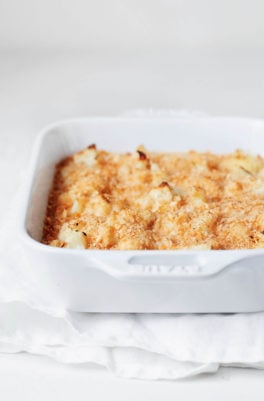
Leave a Comment
This looks great. I have a ton of cauliflower right now and am looking for ideas on how to use it. Does the sauce freeze well?
Hi Janet,
Yes! The sauce will freeze well for up to 6 weeks. Hope you enjoy.
G
This was delicious!! I served this with penne, kale, and peas and loved it. I had the leftover sauce with linguine, sautéed mushrooms, and kale the next night. My husband and I absolutely devoured it both times. So tasty!
Awesome! I’m so glad to hear that 🙂
planning to make this recipe tonight and i’m very excited ! i have one question about an ingredient, i’m having trouble finding white miso, can i use something like an instant white miso soup packet? i’ve never purchased or used white miso so i’m a little confused haha
Hi Abigail! You may already have made the recipe, but the miso really provides saltiness most of all (as well as a little umami). I think you could omit the miso and just increase the salt to taste, if you like. Hope it turned out well!
I can’t praise this recipe enough. Thank you so much for this. Turned out absolutely delicious. I’ve never been more excited to cook and eat an entire cauliflower. What a amazing way to add more veg to my diet (added in some kale too). I upped the amount of miso paste, and added some Dijon mustard. Then finished off with some nutmeg and a garnish of fresh parsley. Next time I’m excited to try it with cashew butter instead of tahini.
So delighted to hear that you like the recipe, Rory! Love the idea of adding Dijon mustard (and more miso is always yummy).
Gena,
I have recently been trying to incorporate more vegan or vegetarian meals into my family’s diet over the last couple months and have been looking to expand my recipe repertoire. I found your site through a list of the ’50 top vegan bloggers of 2021′. I saw the image for the above cauliflower alfredo recipe on your home page and it lured me in. I must say though, as a first time visitor, I was disappointed to see that about half of the page for the first recipe I ever viewed seems more like an advertisement for a symbiotic supplement than anything recipe related. I am hoping this is not a trend in your posts, or it will likely be a deterrent. Just a first impression opinion from the perspective of a new viewer of your page.
Haven’t made the recipe yet, but I agree with the previous review about the advertisement for a symbiotic supplement.
I was looking for Amazing tasty recipes like you have mentioned here. It gives me really strenght to cook like you. Thanks for this and keep sharing.
Gena,
I love your recipes and I so look forward to buying your next cookbook. However, I’m disappointed in the number of advertisements on your website. I know it is one way for you to make money, but I’m seeing as many ads as I do recipes and it’s overwhelming to visit your site because of it. Would you please consider having less ads on your website or putting them all at the bottom or side of the page? Thank you.
Hi Clare,
Thank you so much for reading and supporting my work. I appreciate your feedback, and I’ll take it into account as I continue to work with my ad network on optimizing placement and space.
G